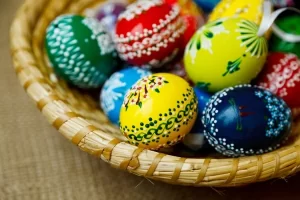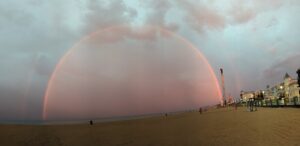(Before we get started – this isn’t about LGBTQ issues.)
I’ve been reading “Manifold Witness: The Plurality of Truth” by John Franke. It’s a good book, which I would highly recommend. Franke presents the idea that the Christian faith is inherently and necessarily pluralistic – not locked into a single doctrine or understanding or method of worship. Aside from a very few fundamentals, we should not be at all surprised that the church experiences so many different understandings and approaches to Christianity – partly because of the huge diversity of people that must approach God through their faith.
Not long ago, I would have rebelled at this idea. With my literalist, Biblicist understanding of scripture (read “The Bible Made Impossible: Why Biblicism Is Not a Truly Evangelical Reading of Scripture” by Christian Smith for an introduction to and critique of Biblicism), I could not imagine that there was not one single correct way of interpreting the Bible and understanding and worshiping God, if only we could discover it and proselytize all mankind into agreeing with us.
What I’ve been discovering in the last year or so is how much that view of faith and Bible was deeply rooted in a Western mindset strongly shaped by the Enlightenment and the Age of Reason and thinkers like John Locke, Denis Diderot, Jean-Jacques Rousseau, and scientists like Copernicus, Galileo, and Newton. I’m an engineer by trade, and in my world, everything can ultimately be reduced to true or false, factual or not, working or broken. I inhabited a dualistic world – there were only two possibilities to anything. This is a central tenet of Reason – that the human mind can be corralled into a proper understanding of each and every thing or theory or fact.
What this outlook natively breeds in the human mind is a need for certainty. It’s very disconcerting for a person raised to an Enlightenment mindset to accept that some things may simply be unknowable, or that there might not be a single correct answer.
When it came to religion, this dualism and need for certainty leads to a particular outcome: mysticism must die. There can only be one, and exactly one, correct doctrine. No question about God or Creation can be answered with “I don’t know” or “it’s impossible to know.” To a rationalist, the answer is “I may not know YET, but I will if I study long enough.”
So naturally, within that dualistic view of religion, there could always only be one single correct faith.
That’s not to say that any of us really KNEW that one single correct faith. But, we reason, our elders must know it; after all, they act utterly certain about THEIR faith. Since I don’t know it, but they do, I must trust them, or the revelation God gave to them before I came along. But either way, I had to trust that it was possible to know that one correct faith, and it would be unfaithful of me to question it.
I no longer hold such certainty. In fact, I’m beginning to sense that such certainty is probably a great way to block our ability to be led into deeper and deeper truth by the Holy Spirit.
For the last couple years, I’ve been bouncing around between a number of churches, from a nicely integrated United Methodist church that values social justice, to a tiny Sunday service cooperatively run by a pluralist, ecumenical, but mostly fundamentalist group of folks for a homeless shelter, to a “True Holiness” Black gospel church, to an elderly mostly-white gay-affirming Episcopal church, to an independent fundamentalist Black church, to an unaffiliated, seeker-friendly, softball theology, middle-to-upper-class, highly-diverse church.
What strikes me is that, despite wildly differing understandings of various doctrines and social concerns and manners of worship, each church honors God, serves Jesus, listens to the Holy Spirit, and values community. And I enjoyed each in different ways, and could enjoy worshiping with them, and could find something of value in the sermons.
So this morning, as I was reading “Manifold Witness,” and musing about plurality, the following thought struck me: Faith, perhaps, should be something like a basket of Easter eggs: each one colorful and unique and ornate in its own way, each containing something different and surprising, but all together comprising the totality of Christianity, in the promise offered by Easter Sunday.

Imagine how much less rich if all those eggs were identical. We’d basically just have a carton of eggs.

Or maybe, imagine a rainbow with just one color. (Yes, it’s a real thing, called a “monochrome rainbow,” usually right at sunset when the sun is so low on the horizon that only red light is getting through.)

And yet that’s what we are trained to attempt: insisting that our church is more correct, more righteous, more holy, than the others. They may have a bit of the truth, but OUR church has it RIGHT. We can fellowship with them, but never could we admit they’re right too, because we can’t both be equally right… right?
How arrogant.
How disappointing.
How uninspiring.
There’s an image that has inspired me, in Daniel 10 through 12, where Daniel tells of his vision of a man above the waters, dressed in linen, who carries great authority and also beauty. Daniel 10:6 says “His body also was like beryl, his face had the appearance of lightning, his eyes were like flaming torches, his arms and feet like the gleam of burnished bronze, and the sound of his words like the sound of a multitude.” I believe it’s a pre-Christ picture of the assembled body of Christ, given full authority by God to rule and reign, a multitude of voices speaking in unity. In Biblical imagery, water often represents the sea of humanity, so “above the waters” can represent this being having arisen out of humanity. This man above the waters swears “by Him who lives forever,” so it cannot be a theophany, a direct appearing of God or Jesus, but he clearly is given authority to speak God’s word directly to Daniel.
At any rate, here’s a fascinating detail from Daniel 10:6: “His body also was like beryl.” Beryl is a fascinating gemstone whose basic component is beryllium aluminium cyclosilicate – and this gemstone presents as six specific colors. (Did you know that in Biblical numerology, the number of man is six?)

Here’s another interesting fact: the very thing that gives each of those gemstones its color is impurities. Aquamarine is caused by iron 2+ impurity. Red bixbite beryl is colored by manganese. Emerald is colored by chromium or vanadium. Goshenite beryl, although colorless, has numerous impurities (interesting: one might be temped to assume it is pure because it’s colorless!). Yellow heliodor beryl is infused with iron 3+. Pink morganite beryl is colored by manganese 2+.
If any of these varieties of beryl were perfectly pure beryllium aluminium cyclosilicate, you’d have the equivalent of a basket of white eggs. Not anywhere as intriguing as those rich colors, and nowhere near as valuable. The colorless goshenite beryl is the least valuable of all, but it’s still a gemstone.
And as gemstones, their beauty is most visible in reflecting and refracting the light falling upon them. Gems don’t produce any of their own light. What makes them beautiful is light falling upon them.
So think about this: a pre-Christ vision of the completed, assembled, united Body of Christ is described as having a body composed of a variety of some of the richest colored gemstones available, in all their splendor, living and functioning as one, and coloring and scattering into a veritable rainbow of shades the pure white light of the Kingdom of Heaven that falls upon it.
It sounds stunning, and it’s no surprise that Daniel was so awestruck that he fainted and was speechless for some time.
So in this season, I’m increasingly aware of the need for variety in the Body of Christ, in the Kingdom of Heaven. It’s not about sameness; it’s explicitly about diversity and plurality, showing forth the rich glory of God to the watching world.
What’s the takeaway? Maybe it’s as simple as this: walk in what the Lord has given to you. But recognize that your doctrine, your awareness of God, your interpretation of the Bible, may well be true, but it’s not Truth with a capital T. You may be right, but there are others that disagree with you who are also right. That’s a mystery! Our views and doctrine must necessarily be incomplete, and cannot be complete, because we’re limited. We can never individually represent the entire infinite glory and goodness of God, because any of us – or any group of us – is far too limited. God, I think, is just fine with the diversity of expressions, and I think it’s safe to say that He designed us that way. Rejoice in it, and relax about confronting others with a different understanding, because chances are pretty good that God is fine with it, and He’s even in both understandings.
I’ve taken to calling this “doctrinal humility.” I’m keenly aware that I am limited, and so my understanding is limited. And I’m also keenly aware that anyone who insists that they are fully correct is… incorrect. And arrogant about it.
Finally, a recommendation. I’m halfway through a book study on “Faith After Doubt: Why Your Beliefs Stopped Working and What to Do About It” by Brian D. McLaren. If I could point you towards a single book at this time, I’d say to start there. He talks about stages of faith, and one of the important stages is becoming aware that there are things that are just not simple black and white, not even really more complex shades of gray, but often even things that are unknowable and mysterious and that’s just okay. If you’re following my blog or podcast, you probably already have some doubts and questions, and you’ve already seen some of the challenging questions I’ve posed. This book has given me a lot of peace that this deconstructing, reconstructing stage of my faith is perfectly normal, and actually a good thing that leads to greater maturity. But “Manifold Witness” has added some interesting awareness, in pointing out that these questions, these seeming variations in understanding and interpretation, are not only okay, they’re part of God’s plan. His people are meant to be a spectrum, a rainbow, of faith for the world to see.
By the way, if you’re disappointed – or conversely if you’re pleased – that I didn’t use “rainbow” to refer to LGBTQ issues in this post, well, I’m sorry/not-sorry. I wish that such a potent symbol of God’s eternal love for mankind hadn’t become political. So I’m just going to use it the way it should be used: to refer to a spectrum of colors. Amen, so be it.
Anyway, thanks for your time. We’ll talk again soon.
